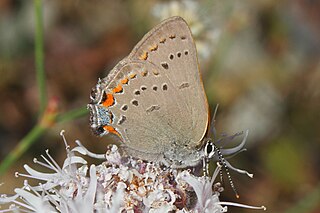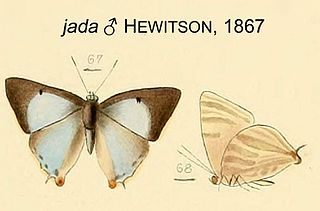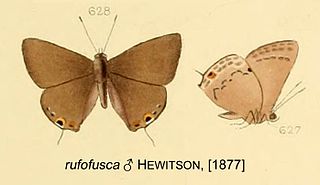
The genus Satyrium contains butterflies in the family Lycaenidae. The species of this genus are found in the Holarctic ecozone. For distribution information see Further reading "Le genre Satyrium".

Satyrium californica, the California hairstreak, is a butterfly of the family Lycaenidae. It is found from British Columbia south to southern California and east to Colorado.

Arawacus jada, known generally as the creamy stripe-streak or nightshade hairstreak, is a species of hairstreak in the butterfly family Lycaenidae.

Strymon bebrycia, the red-lined scrub-hairstreak, is a species of hairstreak in the butterfly family Lycaenidae. It is found in North America.

Strymon martialis, known generally as martial scrub hairstreak, is a species of hairstreak in the butterfly family Lycaenidae. Other common names include the Cuban gray hairstreak and martial hairstreak.

Strymon rufofusca, known generally as the red-crescent scrub-hairstreak or red-crescent hairstreak, is a species of hairstreak in the butterfly family Lycaenidae.

Electrostrymon angelia, the fulvous hairstreak, is a species of hairstreak in the butterfly family Lycaenidae. It is found in North America.
Cyanophrys miserabilis, known generally as the Clench's greenstreak or miserabilis hairstreak, is a species of hairstreak in the butterfly family Lycaenidae. It is found in North America.

Erora quaderna, the Arizona hairstreak, is a species of hairstreak in the butterfly family Lycaenidae. It is found in North America.
Satyrium ilavia, the ilavia hairstreak, is a species of hairstreak in the butterfly family Lycaenidae.
Strymon yojoa, the yojoa scrub-hairstreak, is a species of hairstreak in the butterfly family Lycaenidae.

Satyrium semiluna, known generally as the sagebrush sooty hairstreak or half-moon hairstreak, is a species of hairstreak in the butterfly family Lycaenidae. It is found in North America. The MONA or Hodges number for Satyrium semiluna is 4277.1.

Ministrymon leda, the leda ministreak, is a species of hairstreak in the butterfly family Lycaenidae. It is found in North America.\
Chlorostrymon maesites, known generally as amethyst hairstreak, is a species of hairstreak in the butterfly family Lycaenidae. Other common names include the maesites hairstreak and verde azul hairstreak.

Satyrium caryaevorus, the hickory hairstreak, is a butterfly of the family Lycaenidae. It is found in eastern North America, from southern Ontario west to Minnesota and Iowa, south in the Appalachian Mountains to eastern Tennessee.
Satyrium kingi, or King's hairstreak, is a species of hairstreak in the butterfly family Lycaenidae.
Satyrium auretorum, or gold-hunter's hairstreak, is a species of hairstreak in the butterfly family Lycaenidae. It is found in North America.
Cyanophrys goodsoni, known generally as the Goodson's greenstreak or Goodson's hairstreak, is a species of hairstreak in the butterfly family Lycaenidae. It is found in North America.











